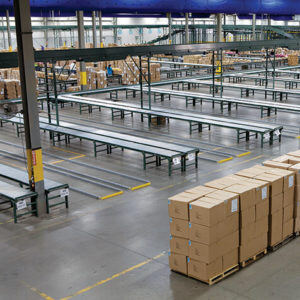What Do Warehouse Conveyor Systems Do?
by Brian Reaves, on Jul 26, 2024 11:52:07 AM
 Have you ever watched a trail of ants marching in lines to and from their hill? A warehouse without a conveyor system is very much like that ant hill. Workers spend most of their day walking back and forth, carrying goods from one end to the other. That might work for insects, but it's wasted potential in humans. Conveyors transform your facility from a cluster of mindless drones into a modern warehouse of thinking workers who add value to everything they do. Read on to learn how conveyors help eliminate the mindless and take warehouse efficiency to new heights.
Have you ever watched a trail of ants marching in lines to and from their hill? A warehouse without a conveyor system is very much like that ant hill. Workers spend most of their day walking back and forth, carrying goods from one end to the other. That might work for insects, but it's wasted potential in humans. Conveyors transform your facility from a cluster of mindless drones into a modern warehouse of thinking workers who add value to everything they do. Read on to learn how conveyors help eliminate the mindless and take warehouse efficiency to new heights.
What is a Conveyor System?
A warehouse conveyor system is a mechanical means for automatically transporting goods throughout a facility. Conveyors take on various forms depending on a variety of factors, including:
- Product type
- Product weight
- Product dimensions
- Distance traveled
- Travel path
- Transfer speed
However, all conveyor systems transfer goods from Point A to Point B with minimized human effort.
Of course, industrial conveyor systems are capable of more than simple transport. Modern conveyor systems can assist with nearly every phase of material handling. We work with Bastian and Hytrol conveyors to ensure you have access to a complete range of warehouse solutions.
What Are the Benefits of an Automated Warehouse Conveyor System?
Conveyor systems reduce wasted labor by removing the burden of repetitive, manual transport. Used throughout your facility, they can eliminate the need for workers to physically carry goods anywhere in your warehouse. Removing this wasted labor has several benefits that impact your shipping, receiving, and picking operations.
Protect Your Bottom Line
Pickers spend an average of 60% of their workday walking your facility. Automated warehouse conveyor systems eliminate much of that wasted time. That increase in productivity naturally translates into faster picking, shipping, and restocking. All three improve warehouse optimization and customer service, saving you money and actively making you more.
Reduce Injury Rates
Overexertion injuries from lifting, pulling, or carrying activities caused 521,350 days away from work between 2021 and 2022. The potential for these injuries continues to grow as demands on warehouses increase. Conveyor systems reduce the risk of injury by reducing the amount of physical labor necessary in your facility.
What Are the Types of Conveyors?
You're probably most familiar with belt conveyors, such as the ones used in grocery store checkout aisles or the slat conveyors in baggage claims at airports. However, there are over 20 different kinds of conveyors, each with its own function. Of those, the following are some of the most common:
- Belt Conveyor: Simple conveyors that use a moving belt turned by motorized pulleys.
- Chute Conveyor: Metal slides that move goods to a lower level.
- Gravity Conveyor: A channel of cylindrical rollers set at a slight decline. Hytrol gravity conveyors are a popular choice in that category.

- Powered Roller Conveyor: A channel of cylindrical rollers powered by a chain or belt.
- Slat Conveyor: A series of solid panels connected by a pair of chains. The slats allow for mounted fixtures that hold transported goods in specific positions.
- Chain Conveyor: Simple conveyors that use a chain instead of a belt.
- Screw Conveyor: A tube that uses a central auger to move material.
- Tow Conveyor: A towed cable or chain that moves carts or dollies along the floor. These are useful for long distances.
- Sortation Conveyor: Varied conveyor systems that merge, identify, and separate inbound and outbound goods for transport to other parts of the facility.
- Pneumatic Conveyor: Conveyors that move goods by vacuum or air pressure.
- Vertical Conveyor: An elevator-like conveyor for transporting goods between facility levels.
- Walking Beam Conveyor: Conveyors that shift material forward in incremental units. These are best used for applications where goods must sit in a specific spot during their journey, like an assembly line.
- Portable Conveyor: Conveyors that allow operators to move the system throughout the facility. The Destuff-it and Restuff-it are examples of this style.
- Pallet Conveyor: Conveyors that use other conveyor system styles to move goods at the pallet scale. Hytrol pallet conveyors are one of the solutions we offer at this scale.

How Much Do Warehouse Conveyor Systems Cost?
The cost of a conveyor system varies widely depending on the types of conveyors used. Motorized systems cost more to install and maintain than their manual counterparts. However, conveyor systems are highly cost-efficient for facilities with high throughput.
For example, a motorized belt conveyor can cost around $5,000 per linear foot. That might seem like a lot, but compare it to the savings they provide. Suppose you have 25 workers in your warehouse, each making about $40,000 annually. That's $1 million spent in labor each year, 60% of which is wasted walking around your facility. If a conveyor system allows you to reduce that wasted time to 10%, you've recovered $500,000 worth of productive work. That's enough to pay for 100 feet of motorized belt conveyor in a single fiscal year.
That example also assumes that your entire conveyor system requires motorized belts. However, many industrial conveyor systems combine conveyor types, mixing motorization with non-motorized varieties like Hytrol roller conveyors. This combination can dramatically reduce the overall cost.
Your Partner in Warehouse Optimization
Naturally, conveyor systems aren’t for every facility. Each warehouse must weigh the pros and cons to determine if the ROI justifies the expense. That’s where we can help. Our Solutions Team has the expertise you need to determine which type of conveyor system might be best for you. Let us help you find the perfect solution for all your warehouse needs. To learn more about conveyor systems or to request a quote, contact us online or visit one of our locations throughout Georgia and Florida.
Florida
Jacksonville
Lakeland
Ocala
Orlando
Tampa
Winter Haven
Georgia
Albany
Macon
Columbus
Valdosta
Further Reading









